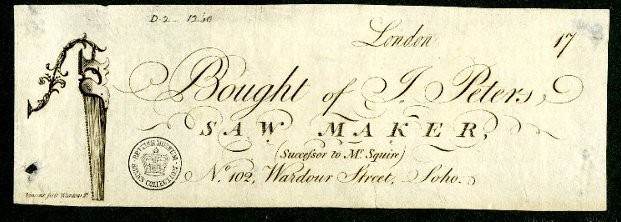The Squire / Peters c1760 Double Stamped Dovetail Saw
Late in 2014 Shane was approached by traditional joiner Richard Arnold, a collector and enthusiast of old tools about making him a copy of his cherished Squire / Peters saw. Over the following months the history of this saw unfolded and we became intrigued by both its story and rarity, Richard’s saw being only one of two known left in existence in the world, the other being owned by a collector in America.
According to author Simon Barley ‘British Saws & Saw Makers from c1660’ William Squire was a London saw maker working from c1754 at ‘The Golden Saw,’ St Ann’s Court in Dean Street and later moving to 102 Wardour Street (Today ‘Snowflake’ ice-cream parlour) Wardour Street, named after then land owner in the area Sir Edward Wardour, was slowly built up from 1686 and even by 1720 not many of the buildings that can still be seen today were in situ. This therefore made us wonder if William Squire may have moved his business from just around the corner in St Anne’s court into brand new premises on Wardour Street, and furthermore was it the new crippling rent and rates that led to a possible bankruptcy and takeover? Sadly, we will probably never know.
At an unknown date between 1760 and 1789, John Peters takes over Squire’s business. Evidence of this we have found courtesy of The British Museum, whereby one of John Peters’ paper business cards is held in storage stating that he is ‘Successor to Mr Squire’ And what a fine example it is. Anyone wishing to view this at the museum would need to quote document number: D,2.1260
What is unique about the saw is that it is double stamped on the brass, I.PETERS in the normal position struck on the front and a minute SQUIRE on the back. This suggests that Peters took over the stock of Squire. So why I PETERS instead of J? In the Latin alphabet the letter J developed from a flourished I, however by the 18th century the 26 letters that we now know to make up the letters in the alphabet were already in existence. However, despite this, toolmakers still carried on with the tradition of stamping I instead of a J well into the 19th century.
The saw itself has a blade length of 11.25” and is a lightweight carcass saw which we feel was designed for intricate joints. Shane believes that it was possibly commissioned as a chair maker’s saw. You just have to look at the size of front doors back in Georgian times to see that people were shorter. Consequently, the grip of this saw although unbelievably comfortable is only likely to fit someone with a palm width of no more than 95mm, however Shane can custom-make the handle to fit accordingly.
As with all of our saws the Squire / Peters Saw is expertly handmade using traditional techniques and the best quality sourced materials available. Shane, made the 400-mile round trip one Friday to MAC Timbers near Peterborough to pick up the rare flamed beech used on the handles on the limited-edition saws. We do still have a supply of this timber and this can be used in the regular saw if the customer wishes. The original handles were made of beech, and we just liked that this was something a little more special and eye-catching than the plain looking beech of yesteryear. An English tree of about 200 years old, the timber itself has provenance as it originates from Boughton House, the estate of the Duke of Buccleuch in Northamptonshire. The flaming in the timber largely occurs in old beech trees due to the minerals in the soil. Shane, has carefully examined all of the worn radii and contours of the original saw and has calculated what these would have been when new. Again the teeth have been re-cut and sharpened many times over the last 250 years and therefore the plate would’ve been noticeably deeper. The only difference Shane has made to the saw (as requested by Richard Arnold) is that he has included our Skelton signature mark of the flat topped brass where it is inlaid flush into the handle. This removes the gap as seen on the original and is actually more pleasing to the eye.
Taking around nine months to get to the stage of making, having to get into the heads of the 18th century saw makers and overcoming a few hurdles on the way. We have to give praise to our amazing stamp maker, Ian Houghton of Chalco Stamp & Die Company who has created by hand some of the smallest and finest makers’ stamps we have seen, perfectly mirroring those of the 18th Century. We loved the story behind this saw and thought a few others might like to share in the remaking of this historic tool, hence the Squire / Peters c1760 Limited-Edition, whereby only 25 will ever be made which are double stamped. Unfortunately, all the Limited-Editions have now all been sold, but we can still produce this saw which includes a single stamp.
Specifications:
· Lightweight Carcass Saw
· Plate Thickness 0.015”
· Blade Length 1-15/16” at heel to 1-5/8” at the toe
· 17ppi / 16tpi rip filed
· 10° Rake
· 0.002” set per side
· Choice of beautiful grade timbers
· Handle hang to blade 40°
· Handle size M Made to the same size specifications as the original However, if requested the handle can be custom made to suit.
· Solid brass back tapers from 5/8” to 9/16”
· Blade is fully tensioned by brass back
· Matches original weight and balance. Recreated to look as it did when bought new in the 18th century
· Stamped with the our exceptional and skilfully made traditional stamp S.SKELTON
